5 Ways Texas Hotels Can Cut Utility Costs
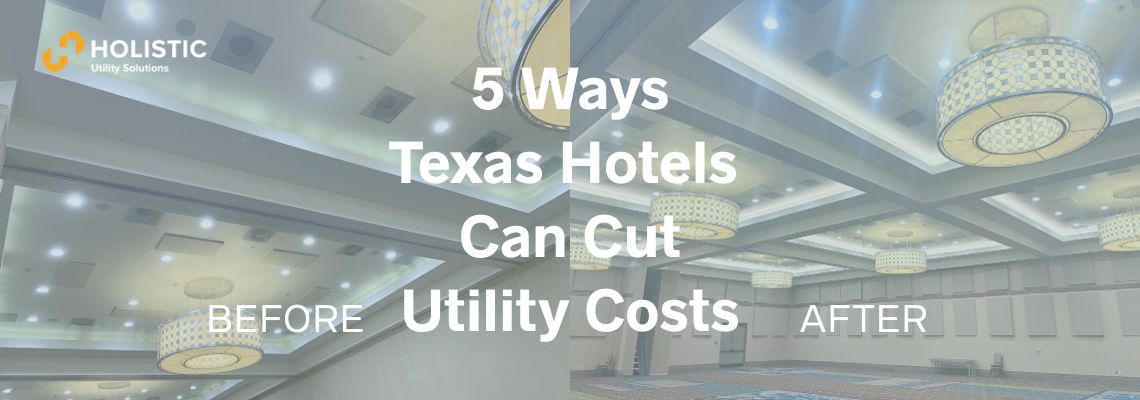
5 Ways Texas Hotels Can Cut Utility Costs
Texas hotels face rising utility costs due to increasing water and electricity rates, high electric and water consumption, and operational inefficiencies. For facility owners and managers, managing these costs is critical to maintaining profitability and sustainability. This guide explores actionable strategies to reduce energy and water expenses through efficiency measures, solar power, and water conservation.
Strategy #1 – Recommission HVAC & Building Automation Systems to Cut Waste
Even if a system was installed and commissioned properly at construction, over time HVAC and control systems drift out of calibration or begin to break down. Faulty sensors, bad actuators, stuck dampers all lead to wasted energy and indoor air quality issues. In the adjacent picture, you’ll see an example of a Hot Water Recirculating Pump on a boiler that was running 24/7. The pump was on a hand switch that was left on. We changed it over to interlock it with the boiler system to only run when the boiler was on.
Commissioning involves systematically checking all control points in a system to ensure they are operating as designed. Point by Point commissioning involves expertise both in Building Automation Systems (BAS) and mechanical systems.
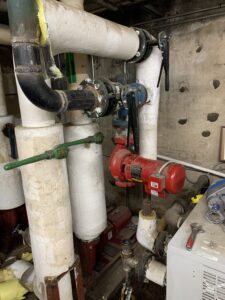
To begin, a detailed commissioning plan should be compiled from the original control sequence of operations, control submittals, and MEP drawings. These are used to develop a step-by-step process of checking each item and confirming it is operating as designed. This process usually involves a technician to operate the BAS while another field verifies the action. For example, a damper actuator is commanded to 100% open and the field tech confirms it actually opens to 100%.
In addition to the field verification, Building Automation System trends should be downloaded and analyzed. Since most of Texas also offers 15-minute electrical usage interval data through Smart Meter Texas, this data should be downloaded and compared against the BAS trends to correlate any control issues to energy consumption.
Recommissioning usually results in to 3-10% energy savings with little to no capital improvements. Cost of commissioning depends on complexity of the systems and size of the facility, but $0.30/sq. ft. is a good average.
Given hotels often run $3-5/sq. ft. in utility cost, a savings of 5% will typically recoup the cost of commissioning in 1-3 years.
Strategy #2 – Control HVAC & Lighting to Maximize Energy Efficiency
HVAC loads and lighting account for over 60% of a typical Texas hotel’s energy consumption. While replacing equipment with more efficient options should also be considered, controlling systems for occupancy may yield faster payback.
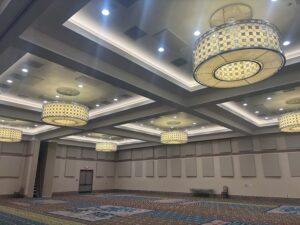
Since common areas at a hotel are typically available 24/7, occupancy control will have little impact on energy consumption. One exception to that is event spaces, as shown on the adjacent picture from a convention center in Texas where we installed a new dimming control system and LED tape lighting throughout all the recessed coves.
While common areas have some opportunities, room level control has a much greater impact. Here’s several methods to accomplish room level scheduling:
Key Card Integration
Room level HVAC control can be implemented in a variety of ways. Some hotels choose to have an interlock system that requires the customer to insert their room card to activate lights and HVAC. This is a good strategy for reducing usage when rooms are vacant, but does decrease usage during the day if guests do not remove their key card when they leave in the morning.
Integration with Check-In/Check-Out Systems
This strategy ties the room thermostat and/or lighting system to the property management system (PMS) to disable lighting and HVAC when rooms are vacant. This provides the same benefit of reducing runtime during times of lower occupancy, but will not shut off rooms during the day when most guests are out of the hotel.
There are other advantages to this strategy. For one, a room can be pre-conditioned prior to the guests expected arrival/check-in. This improves guest experience as they are less aware of the conservation measure.
Secondly, this strategy can be implemented with less physical wiring than an interlock system. Assuming the room thermostat has wireless capabilities, an API integration can typically interface the thermostat with the PMS to complete the process with software only.
Occupancy Sensors
The most drastic approach is perhaps the simplest; an occupancy sensor. This simply interlocks the lights and/or HVAC with a motion sensor. If this strategy is used, be sure to use an Infrared or Dual Technology sensor that can read body heat to ensure the systems do not inadvertently shut off while guests are sleeping.
Integrating one of these technologies can yield significant reduction in energy consumption. Since HVAC and Lighting comprise most of the utility spend, a reduction of 20-30% in runtime can equate to an overall cost reduction of 10-20%. Of course, this value will depend on occupancy of each specific hotel.
Strategy #3 – Manage Electricity Contracts to Lower Your Rates
Most of Texas is a deregulated market, you have options on who your Retail Electric Provider (REP) is and how your contract is structured. The image below (courtesy Power Wizard) shows the areas (in Gray) that you can choose your own provider.
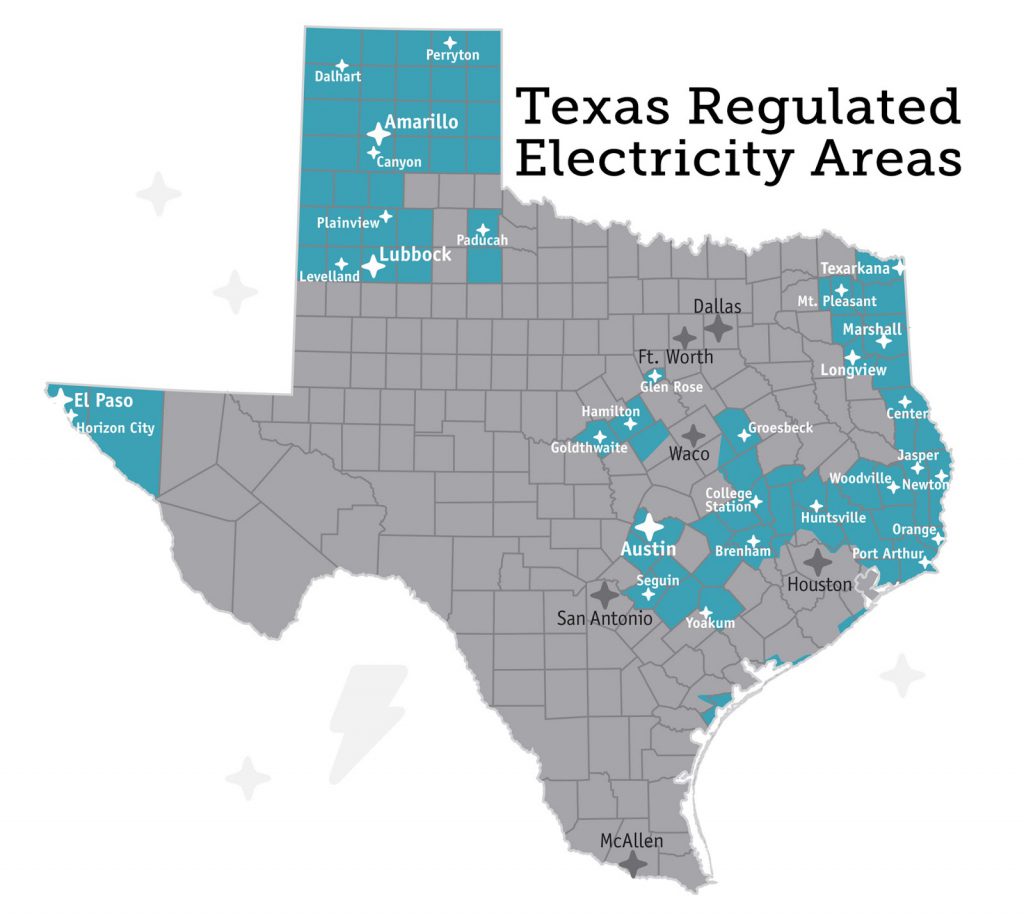
While most commercial facilities are aware of deregulation and the opportunity to manage electricity contracts, not every property is fully optimizing their energy procurement strategy.
A good procurement strategy balances risk and cost. As with many things, the most risk adverse strategy is typically the most expensive in the long run. For example, if you hedge 100% of your power for 5-year contracts, you will not have many big surprises but may also pay a premium vs. a more active strategy.
These strategies may include partially hedging your contracts as prices drop or allowing some portion of the usage to float the market and use other strategies to offset the risk of high cost during expensive purchase hours.
This last point is especially relevant when considering solar and battery systems. Since Texas still sees higher power cost during Summer afternoons and evenings, solar can reduce consumption during the highest price periods and yield greater savings when matched with an active procurement strategy.
While solar is a good strategy by itself, battery and generator systems may also be considered as part of the energy procurement strategy. The highest price times for Texas power are 7-9pm during the Summer. This is due to high demand coinciding with reduction in supply as solar systems drop off the grid. If properly designed and permitted, battery and/or generator systems can run during these times when prices exceed certain thresholds and reduce overall energy cost significantly. This is a form of Demand Response and can provide lucrative savings while also giving you backup power during emergencies.
Strategy #4 – Install Solar Power to Lower Your Consumption
The cost of solar has decreased significantly over the past 10 years. In conjunction with this, the Federal Investment Tax Credit (ITC) is 30% of system cost. Most of Texas gets an additional boost in Federal Incentive through the Energy Community program, as much of the state is considered an EC and qualifies for another 10% ITC.
In addition to the one-time ITC, systems also qualify for Bonus Depreciation. Combined, these tax benefits typically reduce the cost of solar systems by 50-60%+.
Depending on what utility your hotel is in, you may also qualify for additional utility incentive. A good example is the Oncor Commercial Solar Incentive. This one-time payment applies to commercial properties served by Oncor (most of North Texas) and covers approximately $0.50/W of system cost. Given a typical rooftop system is around $2/W, this equates to another 25% of system cost.
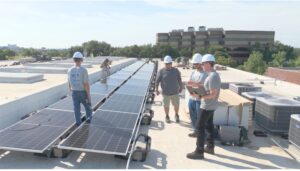
Combining tax incentives and utility incentives often reduces gross system cost by approximately 75%.
For ongoing savings, the largest factor is your site’s cost of power. Assuming a typical rate of about $0.06/kWh, a 100KW system producing 130,000 kWh/yr would save approximately $7,800/yr.
Given this 100KW system should cost around $200k before incentives and $50-100k after incentives, a simple payback of 5-10 years is attainable for many installations. While this may not sound like a really good return, when phrased as an Internal Rate of Return this typically translates to 10-20% IRR. Try getting that in the stock market!
Note that since Texas does not have Net Metering, the size of your solar system is critical. If you size a system for 100% of your consumption, you will overproduce significantly and send that power back to the grid for pennies on the dollar. For more detail on this, read our resource article “The Importance of Property Sizing Solar Systems in Texas”.
Strategy #5 – Implement Smart Irrigation to Shrink Water Waste
Since the largest source of water consumption in a hotel is interior usage, the other large user can sometimes be forgotten.
Landscape irrigation is a significant source of water consumption and cost for most hotels in Texas. As water rates increase due to aging infrastructure, growing population, and diminishing supply, irrigation water costs have reached all-time highs. Local municipalities have also become increasingly stringent about enforcing watering restrictions during drought seasons.
While reducing water is a noble goal, the importance of a healthy, thriving landscape to overall branding and guest experience cannot be understated. The good news is you don’t need to kill your landscaping to reduce your irrigation water consumption!

Managing all the above is impossible without technology. A smart irrigation system uses a combination of sensors, algorithms, and remote programming to determine exactly how much water your landscape needs and adjusts accordingly.
In addition to managing normal irrigation, a good system will also incorporate leak detection. This incorporates a flow meter to monitor the actual water used vs. what should be used. This identifies issues such as line breaks, broken heads, etc.
A good option in this space that is a Texas based company is Weathermatic. They have a nearly 80-yr track record and strong portfolio of customers combined with a low price point that allows payback of 3-5 years on most installations.
Actionable Next Steps
The information above should give you some practical steps to begin reducing your utility costs right away. However, if you’d like to partner with an expert in this area to review each of these five strategies, identify additional opportunities, and create and implement a custom plan for your specific facility, we’re here to help.
Holistic Utility Solutions is based in Dallas-Fort Worth and serves customers throughout Texas and across the country. We specialize in Feasibility Assessments, Project Development, Construction Management, and Ongoing Support.
Reach out today to see how we can help you!


